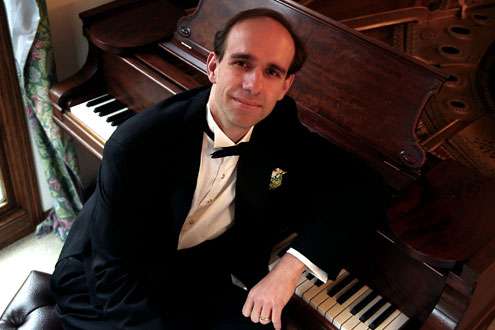|
Back
The Triumph of Love And Joy New York
Medieval Sculpture Hall, Metropolitan Museum of Art
12/11/2012 -
Olivier Messiaen: Vingt Regards sur l’Enfant-Jésus
Christopher Taylor (Pianist)

C. Taylor (© Metropolitan Museum of Art)
More than a Millennium and less than ten feet from pianist Christopher Taylor last night were the literal articles of faith interlacing with Olivier Messiaen’s Vingt Regards sur l’Enfant-Jésus
This so rare performance of the two-hour work took place adjacent to an alcove of Renaissance paintings and sculpture, but Messiaen’s musical liturgy had nothing to do with the age of curiosity and reason. For contiguous to the Medieval Sculpture Hall is the Met’s superb room of icons, reliquaries, sculptures, icons and simulacrum from the years 1050-1300 AD, many of them from the great Cathedral of Amiens in Messiaen’s own country.
These were the years, just after the world was to come to an end in 1000 AD, that Faith and Belief were not “sullied” by reason, logic or doubt. Pilgrims to these great sites might have been a contentious secular group, as in Canterbury Tales, but the moment they saw the relics of the Crucifix or the statues of the Virgin Mary and her Child, they fell upon their knees with a belief untarnished with uncertainty.
And this was the religion of Messiaen’s work last night, played by Mr. Taylor with certitude, resplendence and an artistic faith. The art and the music were simultaneous metaphors of each other.
I confess that going to this concert was originally a chore, a challenge, not a joy on my part. Messiaen was himself an icon of the 20th Century, yet two hours of piano music on a religious theme did not fit in (you should forgive me) with New York’s secular holiday spirit. But from the first quietly majestic chords representing God Itself, the challenge became an honor.
Mr. Taylor has been playing this work for many years now, all 176 pages of the complex score from memory. And where these Renaissance paintings emphasized the Passion of Christ, Messiaen and the 11th Century sculptures reveled in the joy of the Birth and the visions of the Son.

Amiens Cathedral Portal (© Amiens Cathedral)
The fourth aspect of the evening–outside of Mr. Taylor, the Met’s art and Messiaen’s music–were Messiaen’s descriptive words. Far from the dour proscriptions and warnings of another religion and another time, Messiaen’s words reflected that love. “It is the sleeping Jesus,” he describes in the lullaby of I Sleep but my Heart is Awake, “who loves us and gives us oblivion.” “The Joy of the love of God,” he writes for the Gaze of the Spirit of Joy, “happy in the soul of Jesus.”
Happiness too–partly the ecstasy of religion, partly the human happiness he feels–is in the amazing Oriental dance for the same movement. “I have been struck by the fact that God is happy,” he wrote.
That happiness, for Messiaen, had the purity of religion. But God’s happiness is syncretic. it encompasses everything. And everything is part of this music., Partly his beloved birds (he quotes perhaps a dozen birdcalls), partly the mystery of India, partly the musical complexity itself. His music is certainly romantic–no structural form bound him (which is why the late Charles Rosen had little use for the composer). But within that freedom he hid–like the animals hidden in medieval tapestries–fugues, canons, polyrhythms, polytonalities, left and right hands plahying at different paces, expansions of spaces and duration...
(Nor did the composer shy away from these technical descriptions: “Note the divertissement where the upper voice treats the subject in a nonretrogradable rhythm taken out to the left and right, where the bass repeats fortissimo a fragment of the subject in asymmetrical enlargement.”)
Obviously such music takes more than stamina from Mr. Taylor. It takes the most meticulous finger work allied with the most eclectic emotions. But Mr. Taylor, a Professor Music at the University of Wisconsin, took it all in his stride. He breezed in, sat down and played the first ten “regards” with the passion and emotion and musical exactitude necessary. No, he did not toss off the performance the way a mere technician could do it. The bird songs were not emphasized for individuality, but became a chorus of birds. The lullabies began tenderly, built into crescendos (for nothing is simple here) and came back to their original tenderness.
Messiaen wrote about love, but never saccharine, cheesy 19th Century American religious love. He could do battle with lightning and thunder, he could imitate marimbas and drums, trumpets and oboes. All ol this was taken by Mr. Taylor with that joy, almost beatific joy which the music deserved.
By the final triumphant vision (The Gaze of the Church of God), the compose never even tried to disguise his ardor: this was neither subtle nor mystical. It was grandiose and victorious.
Mr. Taylor’s voice and fingers were not those of a church organist. A person in front of me was following the score, and while I was originally tempted to see it, the performance was so varied, so instrumental, it enveloped so many moods–even those jazzy pop-music chords which Messiaen sometimes uses–that I only wanted to hear these wondrous tones.
In the words of the composer himself, Taylor had performed “a triumph of love and joy, tears of joy.”
Harry Rolnick
|